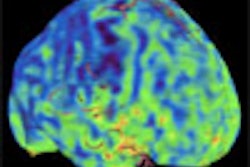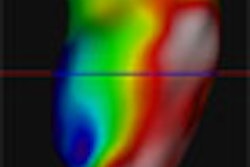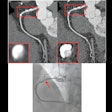In the decades-long struggle between radiologists and cardiologists over control of new cardiac imaging technologies, the heart specialists have an undefeated record. But history may not repeat itself with respect to cardiac CT angiography. In fact, the edge may be shifting to radiology, according to imaging utilization expert Dr. David C. Levin.
Radiology has an excellent chance to retain control of cardiac CTA and reclaim cardiac imaging turf ceded to cardiologists in the 1970s and 1980s, Levin told attendees at the 2007 Radiology Business Management Association's summit, held in St. Louis, MO, earlier this month. Levin is a semi-retired radiologist and former chair of the radiology department of Thomas Jefferson University Hospital in Philadelphia.
Although radiologists pioneered the development of cardiac imaging and were responsible for most of its innovations, they lost the business to cardiologists due to lack of training, lack of confidence, fear of dealing with serious complications that could occur during procedures, and failure to conduct clinical research, Levin explained. Cardiac imaging specialists, including Levin himself, also contributed to their own demise by training cardiologists during the 1970s and 1980s to perform the procedures on their cardiac patients.
The advent of cardiac CT and MR has renewed the interest of radiologists in cardiac imaging, Levin said. CT and MRI technologies have been controlled by radiologists, who understand the physics far better than most cardiologists currently do. More research in this field is being conducted by radiologists, especially those practicing in European countries. Most importantly, because the American College of Radiology has incorporated cardiac imaging subjects within its oral board examinations for certification, residents are motivated to receive training in this field.
Levin contends that radiologists recognize that the need to offer CTA and compete with cardiologists is vital to the overall health and prosperity of the radiology profession. "If we lose cardiac CT and MR to cardiologists, then neurologists, medical oncologists, orthopedic surgeons, and urologists all will want to start offering specialized CT and MRI procedures," Levin said.
There are only two valid reasons for cardiologists to offer CTA exams, according to Levin. Cardiologists know more about cardiac disease and physiology, and know more about the patient's clinical condition than radiologists. The two other reasons most often cited -- that cardiologists know more about coronary anatomy and can convey exam results faster to patients -- can become non-issues.
"Coronary anatomy is not rocket science; any radiologist can learn this," Levin said. "The combination of effective workflow and universal access to exams and reports on a PACS can put a radiologist in the position of conveying results to patients even more rapidly than a cardiologist can."
Another point in favor of radiology control of CTA is that the technique will not be overutilized if radiologists are in control. Unlike cardiologists, radiologists do not self-refer or overutilize a procedure. They also will not be swayed by the opportunity of performing additional studies or surgery.
A number of factors are weighted in favor of the radiologist over the cardiologist, Levin explained. Radiologists have the advantage of understanding how CT and MRI technology works. Cardiac CT and MRI procedures are difficult examinations to do, and an understanding of physics is critical.
Radiologists are trained to look for chest lesions that might mimic cardiac symptoms, such as aortic dissection, lung masses, and pneumothoraces. In a retrospective study by Onuma et al conducted jointly by cardiologists and radiologists at the Mitsui Memorial Hospital in Tokyo, 503 consecutive patients with suspected coronary artery disease underwent diagnostic cardiac MDCT between July 2003 and July 2004.
Of these, 22.7% were also diagnosed with clinically significant noncardiac pathology requiring follow-up. The noncardiac pathologies included malignancies in the lung and the breast in four patients (Journal of the American College of Cardiology, July 18, 2006, Vol. 48:2, pp. 402-406).
The DRA's impact
The Deficit Reduction Act of 2005 has altered the financial dynamics of obtaining a realistic return on investment in an outpatient setting. Unlike most cardiology practices, radiologists can fill scanner slots with non-cardiac patients. Levin believes that in the DRA era, primary care physicians are more likely to refer their patients to radiologists rather than cardiologists, because radiologists will not steal their patients.
But radiologists can't just sit back and let CTA studies come to them. Residents need training in cardiac imaging, and it is the responsibility of radiologists to modify programs to incorporate this. Levin recommended that cardiac anatomy and imaging replace some of the teaching of obscure topics like dwarfism and metabolic bone disease that most radiologists would seldom encounter.
Because today's research is tomorrow's clinical practice, Levin also strongly recommends that more research in cardiac imaging be conducted by radiologists. He also recommends that radiologists lobby the American Board of Radiology in Tucson, AZ, to create a formal section for cardiac imaging.
Because cardiac imaging is not yet a full-fledged specialty, it should be affiliated with thoracic radiology. "Many radiology departments and large practices have a chest section. Cardiac imaging needs to be a part of it," Levin said.
It is also important for radiologists to be visible, to patients, to payors, and to policy makers. "Give results to patients directly," Levin advised. "Patients who have a coronary CTA are very concerned about whether they have coronary disease. They want to know the results immediately."
"Talk to payors and policy makers about the self-referral problem," Levin said. "Reinforce the fact with statistics that if cardiologists have free rein, costs will skyrocket." He added that in Philadelphia, Blue Cross has established a policy that the insurer will not pay cardiologists for coronary CTA because the existing imaging provider network that they use is quite enough to meet patients' needs.
Levin said the best strategy for radiologists who want to retain control of coronary CTA may be to partner with cardiologists, either by inviting a cardiologist to join their imaging practice or by establishing a joint venture with a cardiology practice -- as long as it is a true joint venture.
In either case, Levin envisions a partnership in which both radiologist and cardiologist will jointly post-process images and interpret coronary CTA procedures together. Radiologists alone would be responsible for the technical aspect of the procedure, for supervising the study and interpreting the non-cardiac portion. Cardiologists alone would administer beta blockers and nitroglycerin, monitor the patient after the procedure was performed, and market the joint venture to other cardiologists and cardiac surgeons.
"Collaborating with a cardiologist can at times be like collaborating with a rattlesnake," Levin quipped. "But it is better than rolling over, playing dead, and hoping that the rattlesnake won't bite you. Don't be intimidated by the propaganda of the American College of Cardiology. With the advantages that exist for radiologists, dominance in coronary CTA is for the radiology profession to lose."
By Cynthia KeenAuntMinnie.com contributing writer
May 31, 2007
Related Reading
How to win the coronary CTA turf war, October 9, 2006
Radiologists can win the battle for coronary CTA, May 29, 2006
Am I not destroying my enemies when I make friends of them?, May 29, 2006
Cardiac imaging dazzles, but radiologists can't compete alone, April 10, 2006
Copyright © 2007 AuntMinnie.com



















